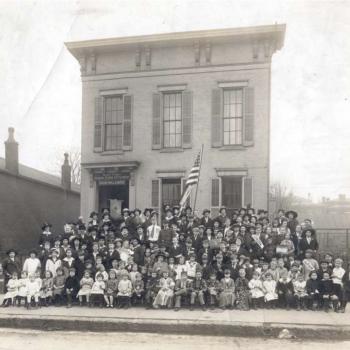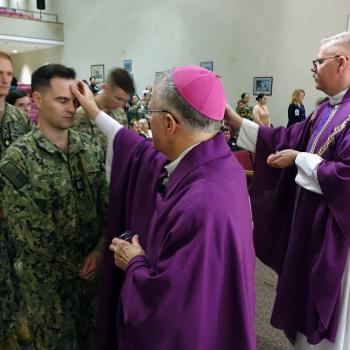Editors' Note: This article is part of the Patheos Public Square on Best Practices for Peace in 2015. Read other perspectives here.
Peace I leave you. My own peace I give you. ~ Jesus (John 14: 27)
Sitting here in the post-Christmas detritus of boxes, wrapping paper, and ribbon, and with a list of things left undone, it's hard to be peaceful. Maybe peace will come when I get my house back in order. Or maybe peace will come when I've done all my end-of-the-year chores. Or maybe peace will really only come as wars cease, boundaries agreeably negotiated, and all is well in the world. Perhaps when we live in balance and our commitment to Earth is renewed we will know peace. Or, as my sister says, maybe peace will finally come when she has thin thighs. In other words, never!
I yearn for peace, and I'm waiting for peace to come.
Holy scripture, however, insists that peace is here, now, already given. Peace is not something far away, nor is it something that someone else has to make happen. No one has to go and find peace and bring it back to me. It is already planted in my spiritual heart, a birthright, given as part of my creation in the image of God and awakened through the gift of God's spirit in Christ.
With this understanding, how do I tap into that peace? How, in my own lived experience, can I realize peace? What contemplative practices will support my desire for peace and help me live from that place? Here are a few suggestions.
Sitting Meditation: Going Deeper
We cannot touch that inner quality of peace by skimming along the surface of life. We have to go deeper. One thing that assists our going deeper is a daily, dedicated time of silent prayer/meditation. We bring to this time our intention to open more fully to God's presence and to let our silent prayer water the seeds of peace already living in our spiritual hearts.
This requires a certain amount of trust, a trust that peace is already there beneath our thoughts, fears, anxieties, and agendas. If your trust is weak, perhaps the first prayer is for an empowered sense of trust that peace is there, living in you. It is yours, a gift to be received, opened, and magnified. A simple "thank you," or sense of gratitude, acknowledges the gift, honors the Giver and opens the door into that inner chamber of peace.
This unambiguous set-aside time allows for spaciousness to emerge. In that spaciousness, there is a taste, perhaps just a tiny sip of the sweet waters of peace. At other times, it may seem like a waterfall cascading over you or a river of peace welling up and flowing through you. Peace then flows from you out into the world. You are the peace you yearn for.
Pilgrimage: Walking Peace
Today, the ancient-yet-ever-new practice of pilgrimage is undergoing a remarkable resurgence across all faith traditions. In our fast-paced society, people need room to go deeper, space and time to hear "deep calling to deep" (Psalm 42). Making a sacred journey is one way of creating that spaciousness. Taken out of their normal routines, roles, and responsibilities, pilgrims begin to discover their true self in God, realizing their oneness with others and with all of creation. When undertaken as a spiritual discipline, pilgrimage can open our eyes to the new life and vision that God is seeking to birth in us and in the world.
One of the participants on a recent Shalem pilgrimage to Iona, the holy island off the coast of Scotland, suffered from spinal stenosis. Her pain was so intense she wasn't sure she could endure the travel. However, through the support of her doctor and family, she was able to come.
A part of this pilgrimage is a day-long walk across the island. We always go no matter what the weather is. Our scheduled day offered the challenges of drenching rain, gale force winds, and a slow slog across boggy terrain.
When our group began the walk that morning, to my surprise, our suffering pilgrim was there. At the halfway point in the walk, most of the group turned back, soaked to the bone and glad to return to the warmth and comfort of our hotel. Only a few continued for the whole day. To my amazement, this pilgrim went the whole way, returning at dusk, radiant from the journey. I couldn't imagine how she had done it. This is what she told me: "When I began, I wanted each step to be a prayer for peace. There is so much need in our world. I knew there had to be many steps. So I just kept going, each step a prayer."
Your pilgrimage may be to far away places or perhaps to a nearby park. With each step, you can convey peace to all. Each step can be a prayer for peace.
Chanting: The Sound of Peace
The word shalom, often used as a simple greeting and mostly translated as "peace," holds meanings far deeper than the casual ways we frequently use it. All the goodness of God is held in this word, the fullness of God's mercy, love, truth, justice, compassion, beauty, forgiveness. In other words, peace is wholeness.
We often begin and end our prayer/meditation time by chanting the word shalom. At the beginning of prayer, the chant draws us deeper into a still open presence for God. As we end our meditation time, the chant extends our prayer for shalom, for all the goodness of God, to all of creation and the cosmos. With this intention, we then move into words and actions, knowing that peace lives in us and is wanting to shine forth. We need not wait for others to bring peace; we are invited to live this moment, and the next moment, in the fullness of peace wherever we are.
1/7/2015 5:00:00 AM




